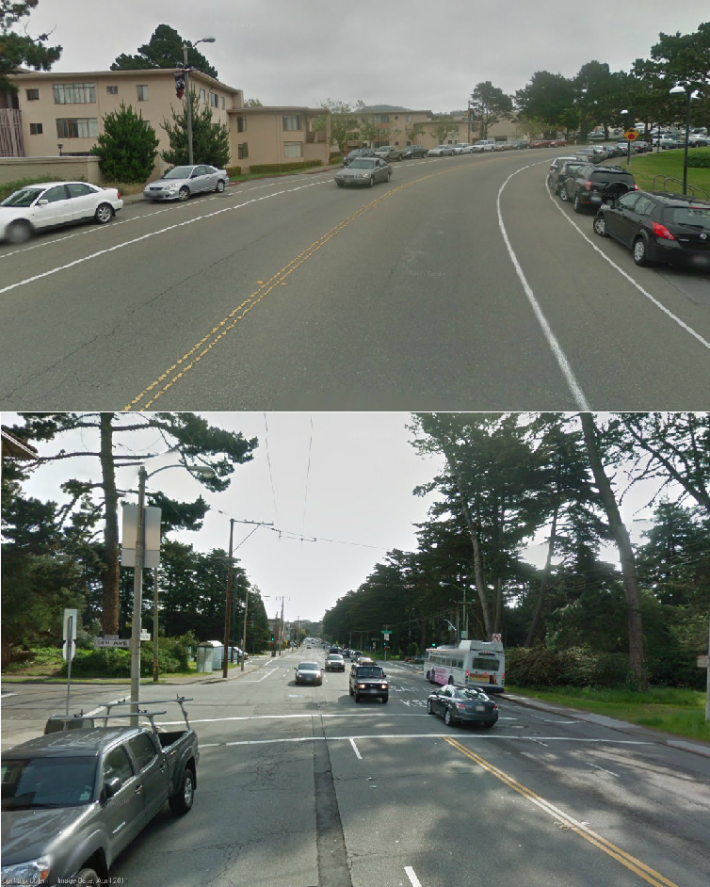Tomorrow's bi-weekly SFMTA engineering hearing has a couple of peculiar items on the agenda:

ESTABLISH – 30 MILES PER HOUR SPEED LIMITWinston Drive between Buckingham Way and Lake Merced Boulevard (existing speed limit is 25 miles per hour)
ESTABLISH – CROSSWALK CLOSUREClosing of the western crosswalk (between the northwest and southwest corners) at the intersection of Fulton Street and Funston Avenue, and close the eastern crosswalk (between the northeast and southeast corners) at the intersection of Fulton Street and 14th Avenue
Speed limit increases and crosswalk closures are unusual for the SFMTA these days -- you'll more typically find speed limit decreases and crosswalk openings on the agenda instead. As the agency notes on its website, the city's adopted Better Streets Plan recommends "that closed crosswalks be evaluated for opening in order to improve access and pedestrian network connectivity" and that the city "reduce speed limits as appropriate and strictly enforce existing speed limits."
So why is the SFMTA taking measures that appear to contradict the city's goals?
Agency spokesperson Paul Rose said that the 5 MPH speed limit increase on Winston Drive, which runs along the edge of SF State University, was requested by the campus police department because the current 25 MPH limit is not "legally defensible" under state law, since the majority of drivers aren't adhering to it:
In order for their officers to cite people who speed using radar on this street, we need a legally defensible speed limit. A 25 mph speed limit would not be legally defensible for radar enforcement because of state speed trap laws. The state legislature created speed trap laws so that local law enforcement agencies cannot set speed limits as merely a revenue generating scheme. We are therefore obligated to take into account the actual speeds used by motorists in setting the speed limit under the presumption that the majority of motorists drive responsibly. The accepted cut-off of a responsible speed is called the 85th percentile speed. In the case of Winston Drive, the 85th percentile speed is 37.0 mph in the eastbound direction and 34.8 mph westbound. We can reduce the speed limit by a limited amount by taking into conditions “not readily apparent to the motorist.” Using those adjustments, the lowest legally defensible speed limit we can recommend for radar enforcement is 30 mph.
As for closing two currently unmarked crosswalks across Fulton Street at Funston and 14th Avenues, which lie next to Fulton and Park Presidio Boulevard -- a notoriously dangerous intersection -- Rose said that instead of installing new curb ramps, the agency would rather prohibit the "marginal" pedestrian crossings:
This will save money on the installation of new curb ramps along Fulton Street at two marginal locations. The Department of Public Works is planning on installing new curb ramps at all marked and unmarked crosswalks along Fulton Street. These intersections are only 70 feet away from the signalized intersection at Park Presidio Boulevard, which is a better location for pedestrians to cross because of the traffic signal control. The quality of the pedestrian crossing at those two locations is further compromised by the recurrent traffic queues blocking the pedestrian path of travel.
But in both cases, taking measures to calm car traffic seems to be a smarter policy than banning pedestrian crossings and making way for drivers to continue speeding -- the very approach of car-centric 20th-century planning that San Francisco seems intent on undoing, according to its stated goals.
"It's frustrating to see the city move backward, not only from improving streets for walking, but from its own stated goal of opening all crosswalks," said Elizabeth Stampe, executive director of Walk SF. "I'm glad SF State police are tackling unsafe conditions, but raising the speed limit is a pretty lousy way to stop speeding; I hope SFMTA will do more to keep students safe."
Rose didn't say whether the agency is planning to implement any traffic calming measures on those streets, but the SFMTA has been improving visibility at intersections along Fulton by removing parking spots at corners, also known as "daylighting" (another recommendation of the Better Streets Plan), along with DPW's planned curb ramps.
The SFMTA engineering hearing, which also includes the Fell and Oak protected bikeways, will take place tomorrow at 10 a.m. at City Hall in Room 416. You can also email staff at sustainable.streets@sfmta.com.




